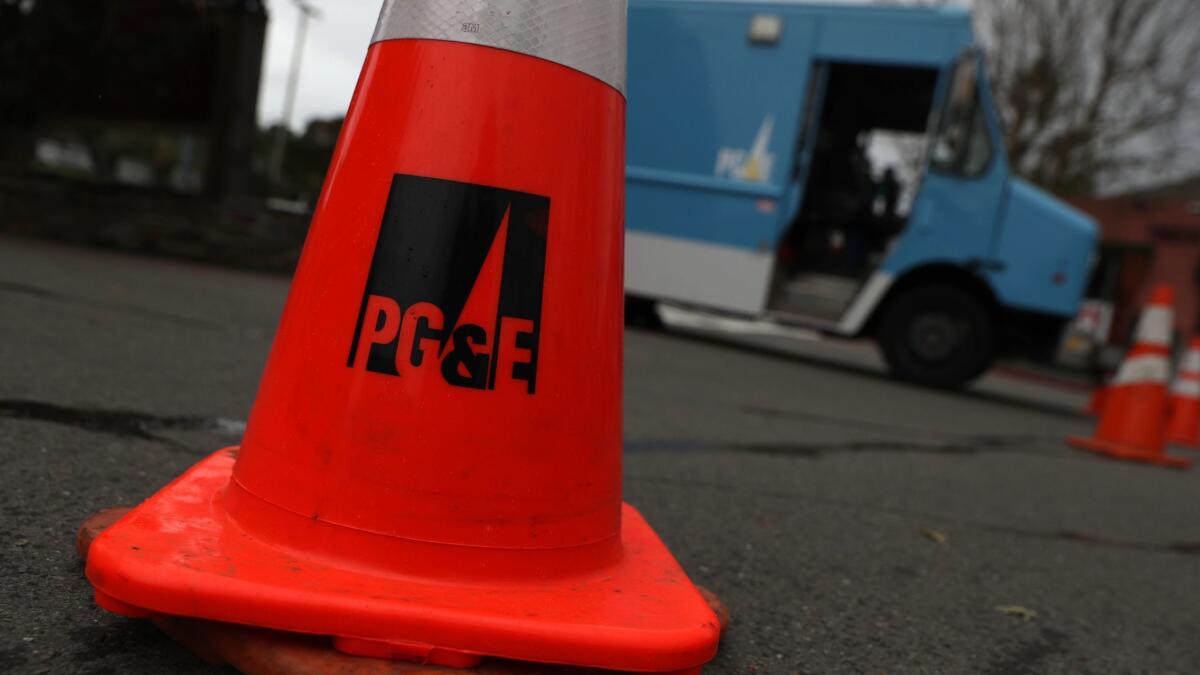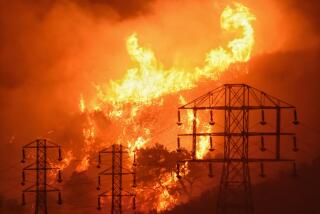A swift fall from political power for PG&E, California’s largest utility

- Share via
SACRAMENTO — Pacific Gas & Electric Co. once had no shortage of political influence or friends willing to step up at California’s state Capitol when the company wanted something.
The utility has spent more than $160 million to lobby officials and support candidates, political parties and campaigns since 2000. Former PG&E executives have served as top advisors to Govs. Gray Davis and Jerry Brown.
But fortunes changed for the company after wildfires caused by its equipment killed scores of Californians and as lawmakers took political risks on a pair of controversial laws to help utilities stay afloat. And this summer, as PG&E sought approval of a plan to use tax-free state bonds to pay victims of the blazes, the state’s largest utility found its own political power had been turned off.
“They have no credibility,” Assembly Speaker Anthony Rendon (D-Lakewood) said. “You can’t trust anything they say.”
Now few politicians, especially those who represent districts in Northern California, want to be publicly associated with PG&E, which filed for bankruptcy in January in anticipation of billions of dollars in damages from wildfires.
Lawmakers feel torn between the need to ensure the utility can continue to provide power to two-thirds of the state and respecting the outrage in areas of California where PG&E equipment sparked wildfires that burned communities to the ground. Some say their generosity has run out.
“It’s one thing if the company has the credibility, the integrity and the respect; then you don’t mind going out on a limb,” Sen. Jerry Hill (D-San Mateo) said. “You don’t mind one time, two times, but it’s a third time and you can’t trust them. I think they’ve put this legislative body in harm’s way, and I don’t think there’s a willingness to go out on a limb for them again.”
Opponents dismissed the proposal as a tax-free bailout and a last-ditch effort to ask the Legislature to rescue the San Francisco-based electricity provider once again, this time by carving out a path to exit bankruptcy without diluting its existing shares.
Doors slammed on PG&E at every turn.
Proponents struggled to get the plan off the ground. The proposal came late in the year, and Senate leadership blocked it from being written into a bill — a basic first step to begin the legislative process. The state Senate agreed to do so last week only after it became certain that the bill would not move forward, according to its author.
“Many legislators thought it was one ask too many from PG&E this session, even if they agree with the policy,” said Steven Maviglio, a veteran Democratic strategist hired by the company’s shareholders to push the proposal this year.
Rendon said it was “obscene” for PG&E to return to the Legislature with another request months after lawmakers approved Assembly Bill 1054, which created a wildfire fund of more than $21 billion for PG&E and other utilities to pay off claims. The fund relies in part on $10.5 billion from customers of investor-owned utilities at a time when more than two-thirds of the state’s residents are concerned about rising utility bills. Last year, the Legislature passed Senate Bill 901, which similarly allowed utilities to borrow money to pay 2017 wildfire costs.
Senate President Pro Tem Toni Atkins (D-San Diego) said there wasn’t much appetite among Democrats to address the new legislation so late in the year, and many were unsure it was necessary. Atkins said her colleagues want to be practical instead of punitive, but she noted that PG&E needs “to take responsibility, and they need to feel the pain.”
As PG&E’s plan languished, numerous reports raised questions about the company’s efforts to prevent wildfires.
A spot check of PG&E’s vegetation management efforts ordered by a federal judge ahead of wildfire season found that the company failed to trim hazardous trees. The utility was aware of dangerous problems with its equipment that could spark wildfires and didn’t perform the necessary maintenance, according to a Wall Street Journal investigation.
Gov. Gavin Newsom and lawmakers have also voiced their frustration with PG&E’s handling of power shutoffs, arguing that the state wasn’t properly warned and some customers may have been at risk.
This year’s proposal would have given PG&E shareholders a method to settle wildfire claims with future profits from ratepayers and exit bankruptcy without diluting their shares — a key company objective as a federal court weighs competing proposals to pay off creditors, resolve the case and determine future control of the utility. This week, PG&E unveiled a plan to pay $18 billion in existing wildfire costs, less than half of what it may owe victims and insurers.
PG&E pledged to take up the legislation again early next year. The company declined to answer questions for this report.
“We firmly believe that Wildfire Victim Recovery Bonds are a critical element to the state’s path forward when it comes to addressing wildfire risk,” the company said in a statement on the failure of the bill.
The bill’s author, Assemblyman Chad Mayes (R-Yucca Valley), said he felt frustrated that his legislation was labeled a PG&E bailout instead of being evaluated on its public policy merit. Unlike prior legislation, Mayes said, all of the money in his bill would be paid with shareholder profits.
Opponents have said PG&E’s request to increase rates on California customers could wash away losses from the bonds. Some noted that in a Capitol run by Democrats, a Republican who doesn’t represent PG&E territory is the one who stepped up to lead the charge.
“Reputation is everything in politics and lobbying,” said Rose Kapolczynski, a longtime Democratic consultant.
“Now utilities are big, complicated entities that are in a dangerous business, but how you deal with the crisis can really affect how the public views you,” she said. “And if the public thinks you’re toxic, no legislator is going to want to carry your bill.”
Decades ago, PG&E and its employees were celebrated in Northern California, said Darry Sragow, who worked as chief strategist for Assembly Democrats for nearly a decade.
“They were among the pillars of the communities,” Sragow said. “They were well regarded. They were trusted. They did very important things that allowed you to light your lights and heat your house.”
Through campaign contributions, lobbying and donations to nonprofits, the utility became part of the fabric of the political community over time. But state leaders’ recent remarks about PG&E show a new level of frustration, Sragow said.
“In the world of Sacramento decision-making, why would anyone go on a limb for that company?” Sragow said. “Either they are not very competent or worse, but you’re going to have to answer to your constituents or to the public. They are in a real bind now.”
Kapolczynski said PG&E has a long, well-documented history of problems over the last 25 years that eroded public trust.
In 1996, PG&E settled a $333-million class-action lawsuit over contaminated water in the Mojave Desert, a case made famous by the 2000 film “Erin Brockovich” starring Julia Roberts.
A federal jury found PG&E guilty of violating pipeline safety standards and misleading investigators after a pipeline blast in the Bay Area suburb of San Bruno that killed eight people in 2010. That same year, PG&E spent more than $40 million on an unsuccessful statewide ballot measure to make it more difficult for municipalities to establish their own electric utilities.
“It was seen as PG&E trying to buy public policy at the ballot box, and that combined with San Bruno the same year really damaged their reputation,” Kapolczynski said. “The handling of the wildfires just reinforced the questions around whether PG&E is being honest with the public about their operations.”
Kapolczynski said the litmus test for PG&E may be whether candidates continue to accept the company’s contributions.
Now frowned upon, oil companies such as Exxon and Chevron were once major contributors to the state Democratic Party, she said.
PG&E gave $3.2 million last year to candidates, political parties and campaigns. The company hasn’t given any money in the first six months of 2019 amid its bankruptcy proceedings.
“I can’t really say that I’ve seen people really highlighting that they can’t take PG&E money yet,” Kapolczynski said. “But the cycle is early.”
Times staff writer Maloy Moore contributed to this report.
More to Read
Sign up for Essential California
The most important California stories and recommendations in your inbox every morning.
You may occasionally receive promotional content from the Los Angeles Times.











